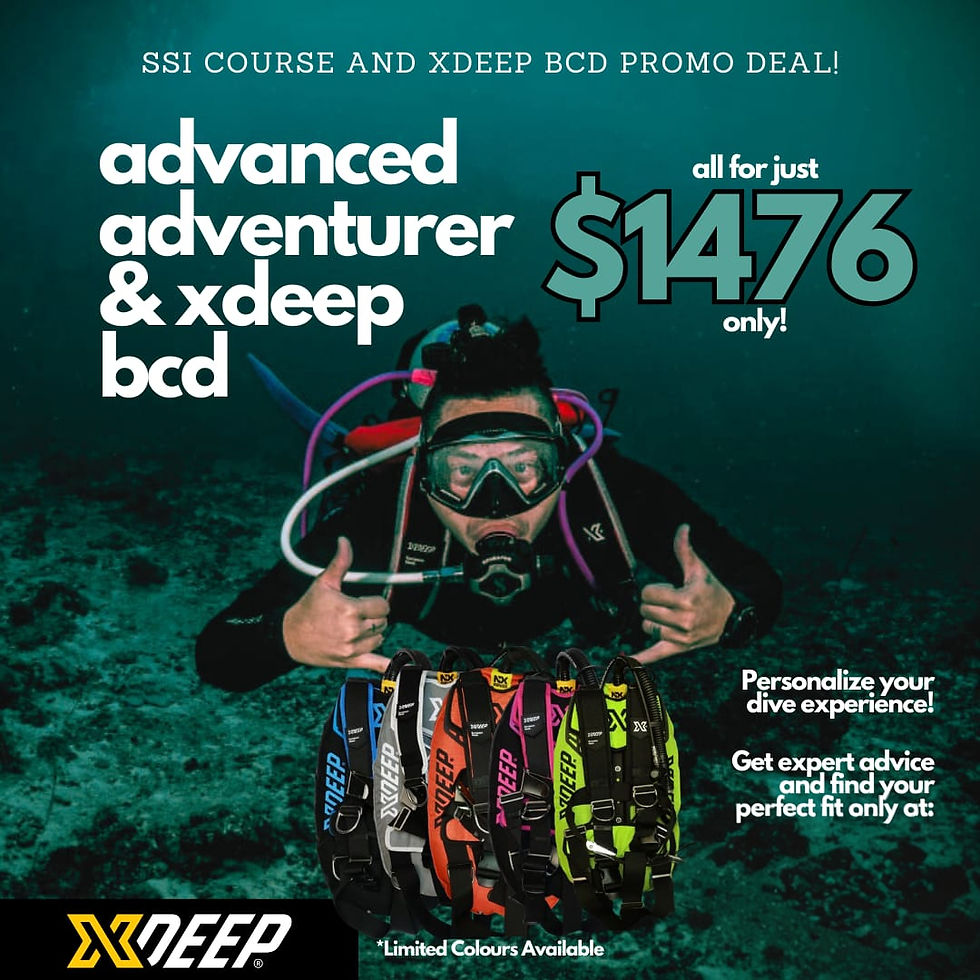Back-Inflate vs Jacket Style BCDs: Which Is Better for You?
- Cuddlefish Divers

- Jul 25
- 4 min read
Choosing the right Buoyancy Control Device (BCD) can make or break your underwater experience. Among divers — whether seasoned pros or curious first-timers — one debate bubbles up again and again: back-inflate vs jacket-style BCDs.
Both styles have their place, but at Cuddlefish Divers, we lean proudly toward back-inflate BCDs for their performance, comfort, and environmental practicality — especially for diving in Singapore’s waters and beyond.
Let’s dive into the pros and cons of each, and why we think back-inflate BCDs are the way forward for most divers.
🤿 What Is a Back-Inflate BCD?
A back-inflate BCD, often called a wing-style BCD, has its air bladder located entirely on the back. It keeps your front uncluttered and is designed to keep you horizontal and streamlined underwater — perfect for better buoyancy control and reduced drag.
Favored by dive instructors, advanced divers, and travelers, this BCD gives you a feeling of freedom and balance that’s hard to beat.
🧥 What Is a Jacket-Style BCD?
The traditional jacket-style BCD inflates at the back and the sides and chest. It hugs you like a vest, and when fully inflated, it holds you upright at the surface. It’s often what you’ll see in dive schools and rental fleets due to its familiar fit and ease of use.
✅ Pros of Back-Inflate BCDs
1. Ideal Trim and Balance Underwater
Back-inflate BCDs naturally keep you in a flat, streamlined position in the water. This improves efficiency, reduces effort, and makes you look like a diving pro (even if you're not… yet!).
2. Streamlined for Singapore Currents
With fewer bulky parts around your chest and sides, back-inflate BCDs reduce drag — helping you conserve air and energy, especially useful when navigating Singapore’s currents or doing drift dives in nearby Southeast Asian waters.
3. Freedom of Movement
No bulk across your chest = easier breathing, more room for accessories, and unrestricted arm movement — whether you’re taking photos, adjusting your torch, or sending up an SMB.
4. Better Buoyancy Control
The rear-positioned air bladder makes your buoyancy more responsive and precise, which is a game-changer when fine-tuning your position over coral reefs or sandy seabeds.
5. Lightweight and Travel-Ready
Many back-inflate systems (especially the ones we use at Cuddlefish Divers) are modular and lightweight, ideal for those traveling around Southeast Asia with just a carry-on and a passport.
❌ Considerations of Back-Inflate BCDs
1. Surface Positioning Needs Practice
At the surface, back-inflate BCDs may push you forward slightly if you're not used to it. But don’t worry — a bit of technique (lean back, use fins for support) makes it second nature in no time.
2. Initial Learning Curve
Beginners may take a few dives to adjust to the different buoyancy behavior. But once you get the feel, you’ll never look back — trust us.
✅ Pros of Jacket-Style BCDs
1. Comfort at the Surface
They keep you more upright when fully inflated, making it easier to float or wait at the surface — especially comforting on your very first few dives.
2. Familiar Fit
Because they wrap around the torso, jacket BCDs may feel more secure for those coming straight from training or rental gear.
3. Storage Pockets
They usually have larger integrated pockets, good for carrying backup gear — though it adds bulk.
❌ Cons of Jacket-Style BCDs
1. Bulky and Less Streamlined
Air bladders around your chest and sides create drag, which slows you down and tires you faster — especially noticeable on longer dives or swims.
2. Trim Challenges
Inflation on the sides can push your body upward in the water, leading to that “standing” scuba position that’s awkward for both buoyancy control and fish photography.
3. Less Customization
Unlike many back-inflate setups used at Cuddlefish Divers, most jacket BCDs come as one fixed system — less adaptable to your diving growth.
🏆 Why We Recommend Back-Inflate BCDs at Cuddlefish Divers
At Cuddlefish Divers, we train, guide, and dive using back-inflate BCDs for one simple reason: they help you dive better, smarter, and longer.
Our dive team loves how back-inflate systems:
Make buoyancy control more intuitive
Improve air consumption
Enhance diver confidence
Allow cleaner trim — especially useful for photographers and eco-conscious divers
Whether you’re diving Pulau Hantu or prepping for your next dive trip to Bali, having gear that works with you makes every dive safer and more fun.
📊 Quick Comparison Table
Feature | Back-Inflate BCD | Jacket-Style BCD |
Underwater Trim | ✅ Excellent | 🚫 Often Unbalanced |
Streamlining | ✅ Sleek | 🚫 Bulky |
Surface Float | 🔸 Needs Adjustment | ✅ Upright Float |
Comfort | ✅ Open Chest | 🔸 Hug-Like Fit |
Travel-Ready | ✅ Lightweight | 🔸 Varies |
Customizable | ✅ High (modular) | 🚫 Limited |
💬 Final Thoughts
Your BCD is more than just a flotation device — it’s your underwater anchor, your gear rack, and your best friend during a dive. If you’re looking for:
Better underwater posture
More natural buoyancy
Reduced drag and fatigue
And freedom to grow with your gear...
Then a back-inflate BCD from Cuddlefish Divers’ gear partners is the right fit.
Dive smarter. Move freer. Explore better. Let Cuddlefish Divers set you up for success.






Comments